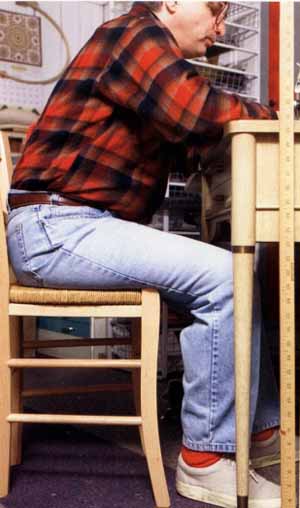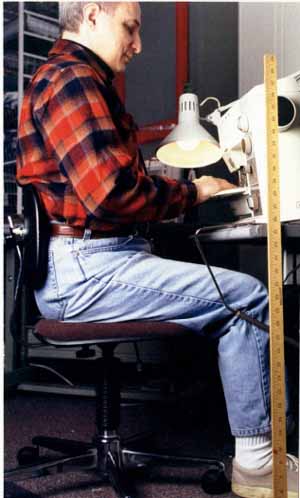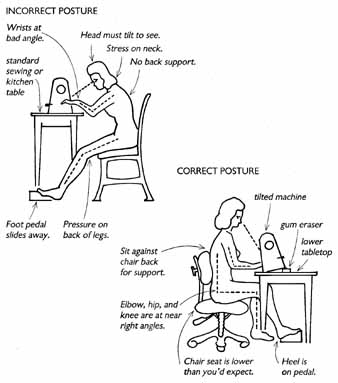Since sewing is a seated activity, a good sewing chair set to the proper
height is a must for the serious sewer. Most people sit in chairs that
are set too high for them.
The height of your sewing chair depends on
your size—-more specifically, on the length of your legs. For comfortable
sewing, you should sit in such a way that there is no pressure on the
backs of your legs. You can accomplish this by lowering the chair or raising
the floor under your feet.
The simplest thing to do, believe it or not, is to raise the floor
under your feet.
Just build up the area in front of your sewing chair
with carpet squares. This way you don’t have to change the height of
your sewing table, something you would have to do if you lowered the
chair itself. By lifting your feet, you lessen the pressure on your
legs, so you can sit comfortably for hours.
The slightly more expensive alternative is to find an adjustable chair, like an office chair, and set it to the correct height. But you’ll have to adjust the tabletop so that your sewing machine is at the right height, too.

The top of this typical sewing cabinet is 31 in. off
the floor, far too high for my 5-ft. 7-in, height. The standard kitchen
chair is also too high. It puts pressure on the back of my upper legs
cutting off circulation. I have to lean forward to see what I am sewing,
which isn't good for my back.
I have three kinds of seats in my sewing room, and I use and like them all. If I am simply reattaching a button to a shirt or jumping from machine to machine, I will perch on a cushion-covered piano stool to do the job. It’s adjustable, has wheels, and slides easily out of the way under a table or in a corner, But if I am going to be sitting at the machine for a long time (to chain-sew patchwork pieces, for example), I need back support so I use a good, armless office chair, sometimes called a secretary’s or typing chair. Like the piano stool, this chair also has wheels and adjustable height. In addition, I can adjust the tension and height of the form-fitting back to fit my posture and sewing needs.
My advice is to buy the best office chair you can afford since you are going to be sitting in it for long periods of time. Your back is worth it. Since businesses are always upgrading their office furniture, you can get good deals on posture- friendly chairs in secondhand office-furniture supply stores. Look in the Yellow Pages under used office furniture. When you go to the office-furniture store, be prepared to see scores of models to choose from. (While you are there, look at desks that can make good sewing tables and shelving that can hold your fabric.)
The third chair in my sewing room is the one I call the finishing chair. When I’m ripping a seam, doing handwork, or simply watching the embroidery machine do its thing, I like to lounge in this chair, It has supportive arms that I could never tolerate when I’m at a sewing machine.

The inexpensive office chair can be raised and lowered
so that my legs are almost at right angles to my body. There is little
pressure on the backs of my legs. The adjustable tabletop is set at
26 in., which brings the sewing surface to 29 in., a comfortable height
for me.
Sewing Comfort The proper height chair and table are essential for stress-free sewing. The illustration on the left shows incorrect posture, which can lead to pressure on the neck, back, legs, and wrists. The illustration on the right shows the proper way to set up your sewing area to eliminate stress. Your height determines comfort; select the chair first, then the table. 
INCORRECT POSTURE: Wrists at bad angle. No back support. Etc. CORRECT POSTURE: Sit against chair back for support. tilted machine; lower tabletop; Chair seat is lower than you’d expect. Heel is on pedal. Etc. |
